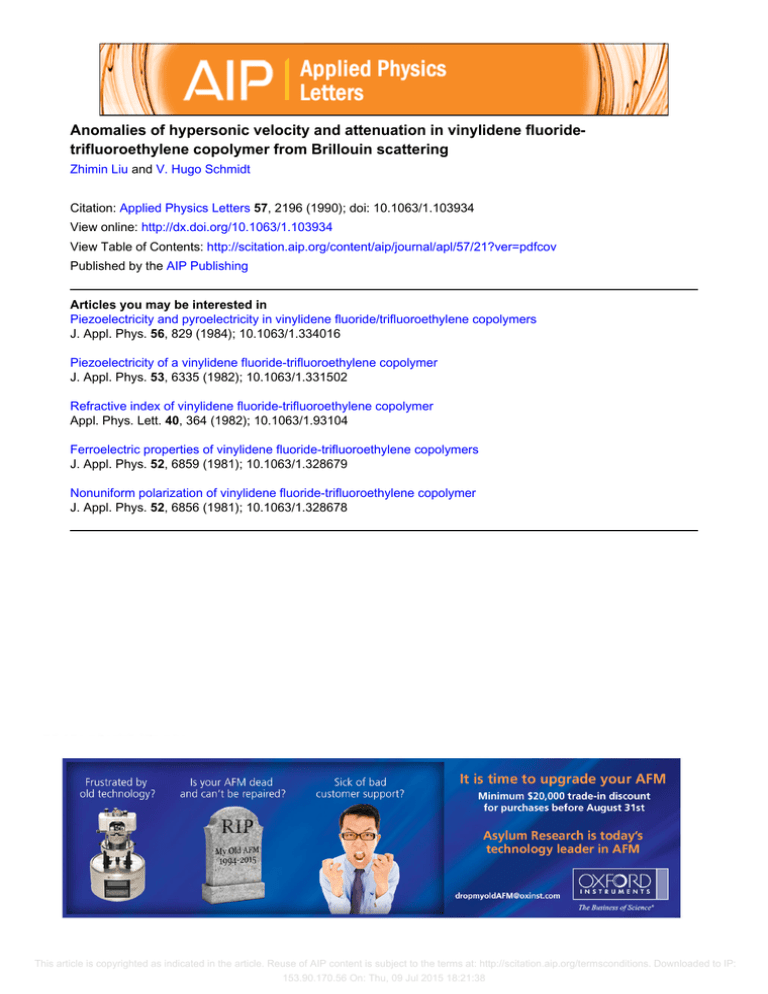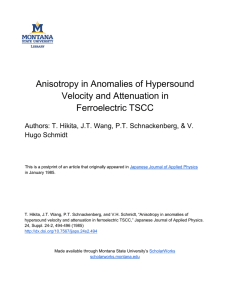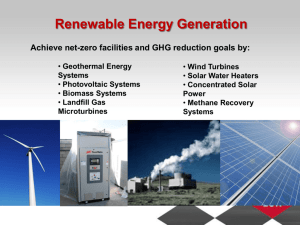Anomalies of hypersonic velocity and attenuation in vinylidene fluoride‐
advertisement

Anomalies of hypersonic velocity and attenuation in vinylidene fluoride‐ trifluoroethylene copolymer from Brillouin scattering Zhimin Liu and V. Hugo Schmidt Citation: Applied Physics Letters 57, 2196 (1990); doi: 10.1063/1.103934 View online: http://dx.doi.org/10.1063/1.103934 View Table of Contents: http://scitation.aip.org/content/aip/journal/apl/57/21?ver=pdfcov Published by the AIP Publishing Articles you may be interested in Piezoelectricity and pyroelectricity in vinylidene fluoride/trifluoroethylene copolymers J. Appl. Phys. 56, 829 (1984); 10.1063/1.334016 Piezoelectricity of a vinylidene fluoride‐trifluoroethylene copolymer J. Appl. Phys. 53, 6335 (1982); 10.1063/1.331502 Refractive index of vinylidene fluoride‐trifluoroethylene copolymer Appl. Phys. Lett. 40, 364 (1982); 10.1063/1.93104 Ferroelectric properties of vinylidene fluoride‐trifluoroethylene copolymers J. Appl. Phys. 52, 6859 (1981); 10.1063/1.328679 Nonuniform polarization of vinylidene fluoride‐trifluoroethylene copolymer J. Appl. Phys. 52, 6856 (1981); 10.1063/1.328678 This article is copyrighted as indicated in the article. Reuse of AIP content is subject to the terms at: http://scitation.aip.org/termsconditions. Downloaded to IP: 153.90.170.56 On: Thu, 09 Jul 2015 18:21:38 Anomalies of hypersonic velocity and attenuation in vinyUdene fluorideatrifluoroethylene copolymer from Brillouin scattering Zhimin Liu and V. Hugo Schmidt Department of Physics, Montana State University, Bozeman, Montana 59717 (Received 21 June 1990; accepted for publication 27 August 1990) The hypersonic behavior of a vinylidene fluoride and trifiuoroethylene (70/30 mol %) copolymer has been investigated by Brillouin scattering without using index matching liquid. Both the glass and ferroelectric transitions are clearly seen in the acoustic behavior. The home-prepared sample has excellent optical properties and let us obtain sound attenuation information in the temperature range of 23-123 "C, which another investigator did not discuss because of the bad optical properties of the sample surface. Anomalies of sound attenuation near the transition point have been observed. Random copolymers of vinylidene fluoride (VF 2 ) and trifiuoroethylene (TrFE) with a VF 2 content ranging from 50 to 80 mol % exhibit a ferroelectric phase transition. 1 The ordered ferroelectric phase (f3 phase) consists of polymer chains with an all-trans conformation, while the paraelectric is disordered with irregular TG, TO ,and TT chain sequences. Kriiger2 investigated the hypersonic behavior of 70/30 mol % oriented copolymers using Brillouin spectroscopy but failed to obtain sound attenuation information in the temperature mage of 23-123 dc. We investigated isotropic samples of 70/30 mol % eVF2/TrFE) copolymer. For oriented (stretched) copolymers the transition behavior seems to be different along the X (stretch) and Y (in-plane, 1 stretch) axes. 2 We present results for sound velocities and sound attenuation in the temperature range of - 50 to + 123°C. We found clearly anomalous behavior of sound attenuation near the paraelectric-ferroelectric transition point in the cooling run. Upon heating, the ferroelectric-paraelectric transition is complete near 100 DC, which is about 17 DC lower than Kruger's results for sound propagating along the X axis in an oriented sample, but very close to their Y-axis result. 2 We also report the existence of multi peak structure in the Brillouin spectrum near the transition point and give an explanation of this phenomenon. The copolymer used was provided in powder form by Atochem Co. We prepared it in transparent film form by the following technique. 3 (1) We put the copolymer powder in a milled-out cavity in one of two parallel copper plates, with special thin plastic films of melting point near 400°C between the copper plates and the powder. Use of these films provides copolymer samples with good surfaces. These pieces of copper were compressed together by a strong spring so that upon heating and melting the powder, the air was driven out, the plates touched, and bubble-free liquid polymer remained in the cavity. (2) We heated the sample up to 200°C for about 10 min, then quenched it in water at room temperature. (3) The film was then annealed above 120°C for 3 h. The film thus obtained has very good optical surface properties so that no index matching liquid is necessary to perform Brillouin scattering experiments. The sample film was placed in an optical cell described previously. 4 Its temperature was controlled within ± 0.2 °C 2196 Appl. Phys. Lett. 51 (21).19 November 1990 using a Scientific Instruments Model 3610 temperature controller. A Lexel Model 95-2 argon-ion laser operating in a single mode at a wavelength of 5145 A and a power level of 300 m W was used as a light source. The power of the beam incident on the optical cell was reduced to 28 m W by polarizers. The scattered light was analyzed by a piezoelectrically scanned Burleigh Model RC-140 5-pass Fabry-Perot interferometer. Finesse optimization and drift control were achieved by a homemade control system using an AIM-65 microcomputer and interface. The natural-phonon linewidth Wph is deduced b y 5 Wph = (W~bs - W~llg) 1/2 - Wins!' where Wobs ' Wins!' and Wang represent the observed, instrumental, and collection optics linewidths, respectively. In our case, Wang = 0.03 FE and Winsl = 0.01 FSR, where FSR (free spectral range) is 16.655 GHz. The measured frequency shift FE is related to the sound velocity V by6 FB=2n( V/A)sin((J/2), (1) where n is the refractive index, A is the light wavelength in vacuum, and e is the scattering angle. Wc used e = 1T/2 geometry scattering, then Eq. (1) reduced t0 6 V = AFB/V'J., where V is independent of n. Figure 1 shows the data for successive heating runs of isotropic copolymer. The glass transition at 1~ concerns freezing out of motions in the amorphous part of the copolymer. The ferroelectric transition at Tc concerns the ferroelectric-to-paraelectric transition of the crystalline part of the materiaL These two transition temperatures separate three regions having different slopes of sound velocity versus temperature. The T~ found from the curve is about - 23°C, using a program to fit the data up to 27 °c to two linear segments described by 7 (2) This is close to Kruger's result of - 16°C for Tg for the oriented sample. The transition from ferroelectric to paraelectric begins at about 53°C. We define Tc as the temperature 100°C at which it is complete. The curvature between 53 and 100 DC is due to coexistence of two crystalline phases. Our transition point is about 17 °C lower than Kri.iger's value of 0003-6951/90/472196-03$02.00 © 1990 American Institute of PhYSics 2196 This article is copyrighted as indicated in the article. Reuse of AIP content is subject to the terms at: http://scitation.aip.org/termsconditions. Downloaded to IP: 153.90.170.56 On: Thu, 09 Jul 2015 18:21:38 2200 HEATINGR~ ~ .§ 2000 >- to) (b) /~(I)--~ /(2)~ \ I- (3 1800 g ~ 1600 Q ~ 1400 o(J) 1200 -70 -30 10 50 90 130 TEMPERATURE ,"C) FIG. I. Sound velocity vs tcmpemture curve from heating run for 70/30 mol % VF2/TrFE. The two lines crossing at Tg are lines fit to Eq. (2). 117 DC. A difference is expected according to Davis's8 report in which both dielectric and x-ray diffraction data show that the transition of an oriented sample is about 10 °C higher than for an unoriented one. This may be because the interaction (across intervening amorphous material) of similarly oriented crystallites in the oriented case preserves the aU-trans structure to higher temperature than in the unoriented case for which these crystallites are oriented randomly. For the cooling run from 123 to -50°C shown in Fig. 2, we observe a broad hysteresis about 50°C wide, from 100 to 55 DC, in comparison with the heating run. The part of the curve from 123 to 100°C is lower than that of the heating run, with almost the same slope. We expected no deviation from the heating run curve because the sample is completely paraelectric in this temperature range. The same behavior occurs in Kruger's X-axis data for a sample annealed for 24 h, but not in their Y-axis data for a similar sample annealed for only 2 h. These shifts appear not to be an annealing effect as Kruger claimed, because our sample was annealed for only 3 h. They may be a thermal history effect, as explained below. If the sample is held at high temperature (about 20 min in our case) between the end of the heating run and the beginning of the cooling run, and also if the sample spends a long time in the heating run, a premelting effect en structure may reduce the sound velocity during that 2200 ~ .s • HEATING RUN .. COOLING RUN 2000 >- I-- U 1800 g,: 1600 o...J o 5 o en 1400 1200 -70 -~ ~ ~ ~ 130 TEMPERATURE (OC) FIG. 2. Sound velocity vs temperature curves from both heating and cooling mns. 2i97 Appl. Phys. Lett., Vol. 57, No. 2'1, i 9 November 1990 FlG. 3. Typical split (a) at temperature 57.6·C and normal (b) Brillouin peaks at temperature 45 'c. Peak types (1-3) are identified in text. All Brillouin peaks belong to their nearest Rayleigh peaks. time. This premelting effect is reversible because the heating and cooling curves coincide again at low temperature in the ferroelectric phase. At temperatures 58,5, 57.6, and 52.2 °C for the cooling run we found that the Brillouin spectrum exhibits a multipeak structure. At these points we took the center position of the whole envelope as the Brillouin peak location to calculate the sound velocity and sound attenuation. A possible explanation for the multiple peaks is that crystallites in some regions of the sample are still in the paraelectric phase while in the remaining regions they have transformed to the ferroelectric phase. If these regions are large compared to the wavelength A, multiple peaks should appear even though the crystallite size is expected to be small (100-200 A) compared to A. The origin of the regions could be nonuniform heating of the sample by the laser beam or (morc interestingly) an elastic interaction between crystallites transmitted by intervening amorphous material. We believe nonuniform heating can be ruled out for the following reason. In Fig. 2 the sharp corner of the cooling run at 55°C extends only over about 3 cC, so this is the upper limit for the temperature variation across the active sample volume. However, the steep part of the cooling curve attributed to phase coexistence extends over 8°C, from 55 to 63°C, so a 3 °C temperature spread cannot account for the simultaneous appearance, described below, of spectral peaks from both phases. Figure 3 shows typical split (a) T = 57.6 °C and normal (b) T = 45°C Brillouin peaks. The truncated outer peaks (1) are the Rayleigh peaks, (2) are the Brillouin peaks, and (3) were identified as reflection peaks. 9 The lower sound velocity determined by the pair of Brillouin peaks in Fig. 3 (a) closer to the Rayleigh peak coincided with the values of the second or third previous (highertemperature) points. These values, near 1635 mis, are attributed to regions with paraelectric crystallites. The higher velocity values coincided with the fourth or fifth later (lower temperature) points. These values, near 1860 mis, are attributed to regions with ferroelectric crystallites. A statistical mixture of crystallites of two phases in their amorphous matrix would result in apparent line broadenZ. Liu and V. H. Schmidt 2197 This article is copyrighted as indicated in the article. Reuse of AIP content is subject to the terms at: http://scitation.aip.org/termsconditions. Downloaded to IP: 153.90.170.56 On: Thu, 09 Jul 2015 18:21:38 1.2,-------------------COOLING RUN N ::I: £2. 0.9 &::: .::;-. ~ 0.6 o 3: ~ 0.3 .. ... : .""".'" 00 :::::i 0.0 '--_ _-'--_ _-L-_ _--L-_ _--.L_ __ -70 130 -30 10 50 90 TEMPERATURE ("C) FIG. 4. Sound attenuation vs temperature from cooling run. ing in the transition regime, but not in the observed multipeak structure. Accordingly we attribute the coexistence of spectra of both phases to long-range elastic interactions between crystallites which cooperatively inhibit or promote their transition to the ferroelectric phase. We could observe such multiple peaks because our cooling run curve is much steeper in the transition regime than curves observed previously,2 perhaps because of smaller local strains giving a narrower local distribution of transition temperatures. A broad distribution would obscure the multipeak structure. Figure 4 shows the temperature dependence of the Brillouin linewidth (FWHM) r hr for the cooling run. The relation between r /rr and the attenuation coefficient a is 5 r hr = a V/1r. A sound attenuation anomaly occurs in the transition range near 55°C. The heating run attenuation shown in Fig. 5 has no clear anomaly. The reason may be that the anomaly is associated with those crystallites which are part ferroelectric and part paraelectric. On cooling, the transition is sharp and many crystallites may be in that class, while on heating the transition is diffuse and few crystallites may be in that class at any given temperature. We attribute the sharper cooling transition to the greater difficulty in nucleating the ferroelectric phase, whose nucleus must consist of several polymer chain segments of proper relative orientation. Except for the above anomaly, the sound attenuation 1.2 N S2. r--------------~ HEATING RUN ~ :z: behaviors are similar for heating and cooling runs. The natural linewidth r Irr increases with increasing temperature. At low temperature ( - 50°C to room temperature) our ~ata are very dose to Kruger's data for oriented samples. Above room temperature, we present the first results of natural linewidth because of the problems in sample surface properties in Kruger's experiment. This linewidth includes contributions from two origins. One has a dynamic origin (phonon decay) which is usually the major factor. The other has a static origin; either there are two types of crystallite groups with different sound velocities or there is a temperature distribution aT over the laser spot area. We believe the IlT effect is not important for the following reason. If the linewidth b.v or corresponding sound velocity spread Il V has mostly a static origin (b. T), generally there should be a direct relationship between /1v and aT, most likely avo:: IdV/dTI. From Figs. 4 and 5, we see the linewidth has some correlation with T, but does not vary as IdV/dTI. Another estimate of the effect of aT comes from calculating the linewidth resulting from b.T alone on the steepest part of the cooling curve where its effect is greatest. There, as T drops from 63 to 55°C, V increases from 1635 to 1860 m/s. For a aT of 3°C discussed above, the corresponding a v is 85 m/s. From Eq. (4), the corresponding linewidth (FWHM) is 0.23 GHz. This is considerably less than the actual linewidth in that temperature range shown in Fig. 4, At low temperature the linewidth approaches that value, but there dV/dTis much smaller, so again aT has little effect on the linewidth. We see that the naturallinewidth has mainly a dynamic origin and governs the sound attenuation a over the whole temperature range except in the paradectric-ferroelectric transition range on the cooling run. In this range, due to the above-mentioned multipeak structure, we can hardly say that the linewidth anomaly in Fig. 4 has a dynamic origin (phonon decay) because this effect appears to be submerged by a static effect. Accordingly, we have not analyzed the attenuation behavior of the sound velocity in detail. We thank Dr. Seymour Preis for his help in teaching us sample preparation techniques. This work was supported in part by Department of Energy Grant No. DEFG06-87ER45292. 0.9 I:: ~ ~ 0.6 o j :J. ~ 0.3 :::::i 0.0 ':-_ _'--_ _L-_--l'--_---1_ _---.J -70 -30 10 50 90 130 TEMPERATURE ("C) FIG. 5. Sound attenuation vs temperature from heating mn. 2198 ; 1. F. Legrand, P. J. Schuele, V. H. Schmidt, and M. Minier, Polymer 26, 1683 (1985). . 2 J. K. Kriiger, J. Petzelt, and J. F. Legrand, Colloid Polym. Sci. 264. 791 ( J986). ] S. Preis (private communication). ~M. Yamada and V. H. Schmidt, Rev. Sci. lnstrum. 49, 1226 (1978). T. Wang and V. H. Schmidt, Phys. Rev. B 34,416 (1986). "c. H, Wang, D. B. Cavanaugh, and Y. Higashigaki, J. Polym. Sci. Polym. Phys. Ed. 19, 941 (1981). 71. K. Kriiger, R. Roberts, H.-G. Unruh, K.-P. Friihauf, J. Helwig, and H. E. Miiser, Progr. Colloid Polym. Sci. 71, 77 (1985). gG. T. Davis, T. Furukawa, A. J. I_ovinger, and M. G. Broadhurst, Macromolecules 15, 329 (1982). 9D. B. Cavanaugh and C. H. Wang, J. App!. Phys. 52, 5998 (1981). Appl. Phys. Lett, Vol. 57, No. 21, 19 November 1990 Z. Liu and V. H. Schmidt 2i98 This article is copyrighted as indicated in the article. Reuse of AIP content is subject to the terms at: http://scitation.aip.org/termsconditions. Downloaded to IP: 153.90.170.56 On: Thu, 09 Jul 2015 18:21:38



